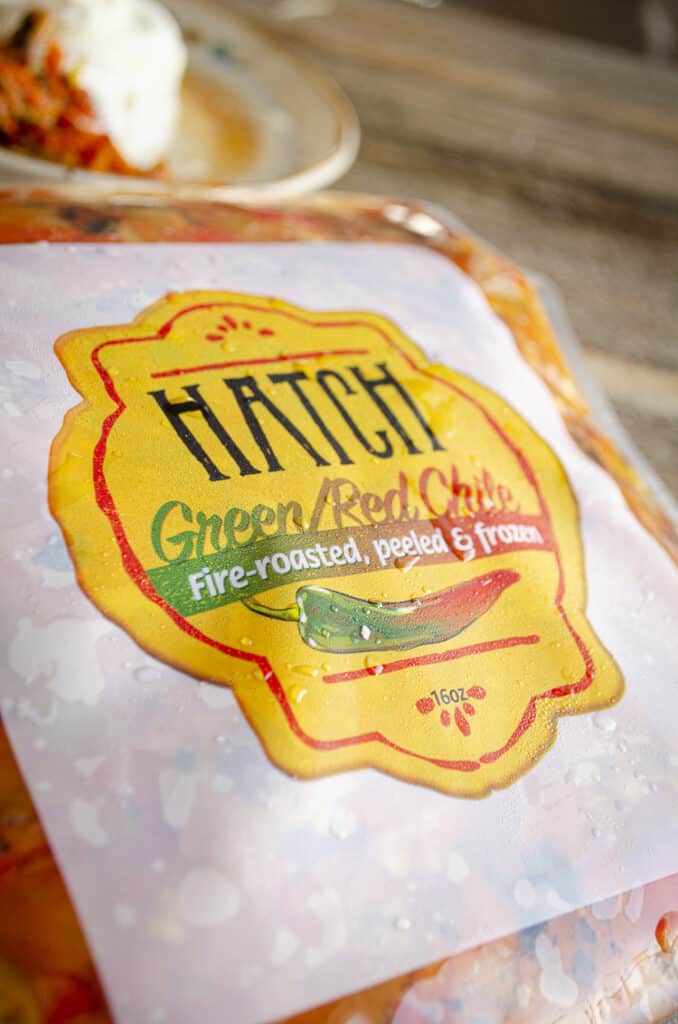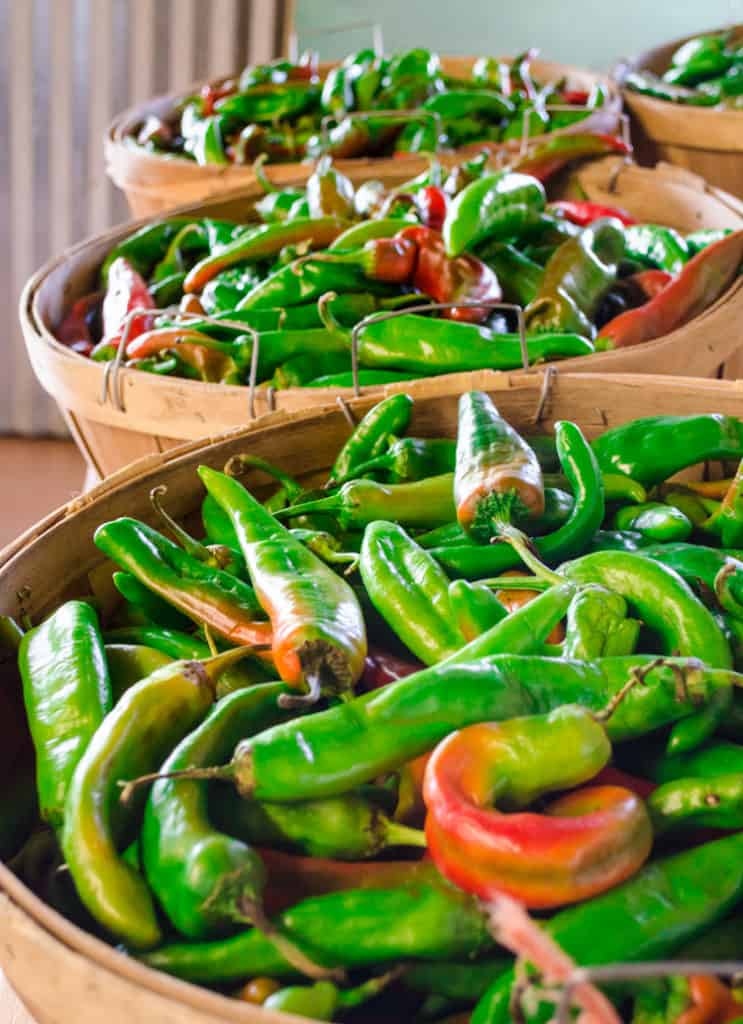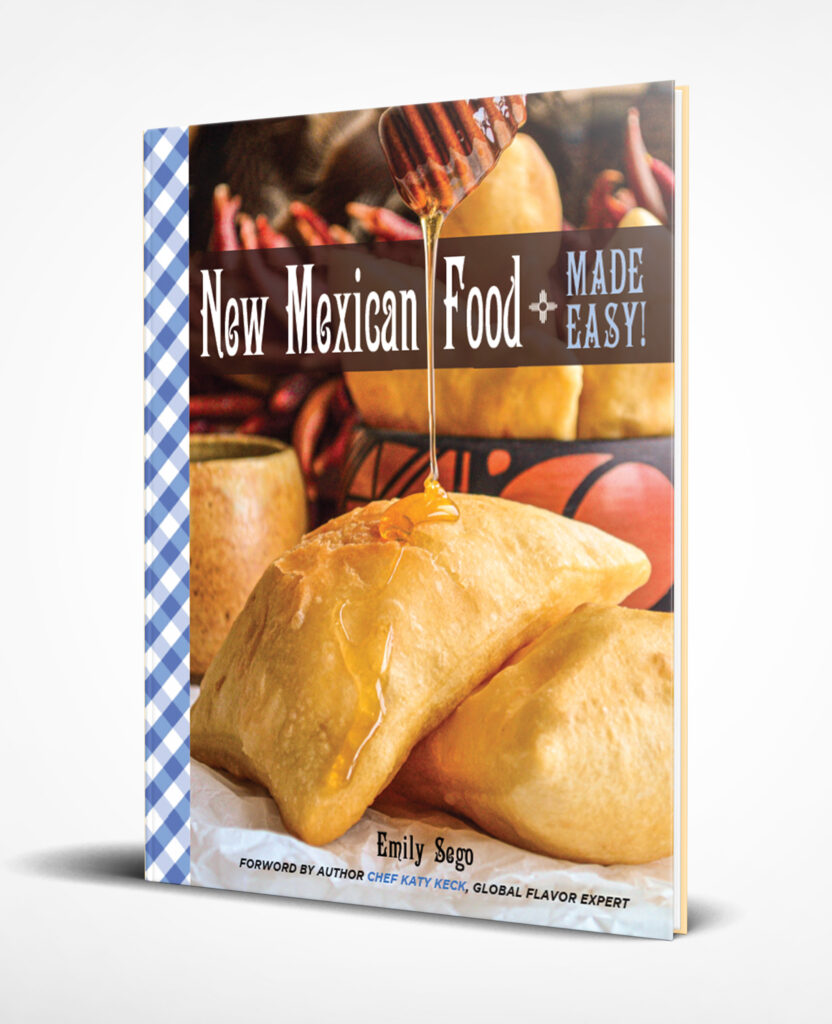Instant Pot Pork Pozole
This post has kindly been supported by The Hatch Chile Store. All thoughts and opinions are my own.
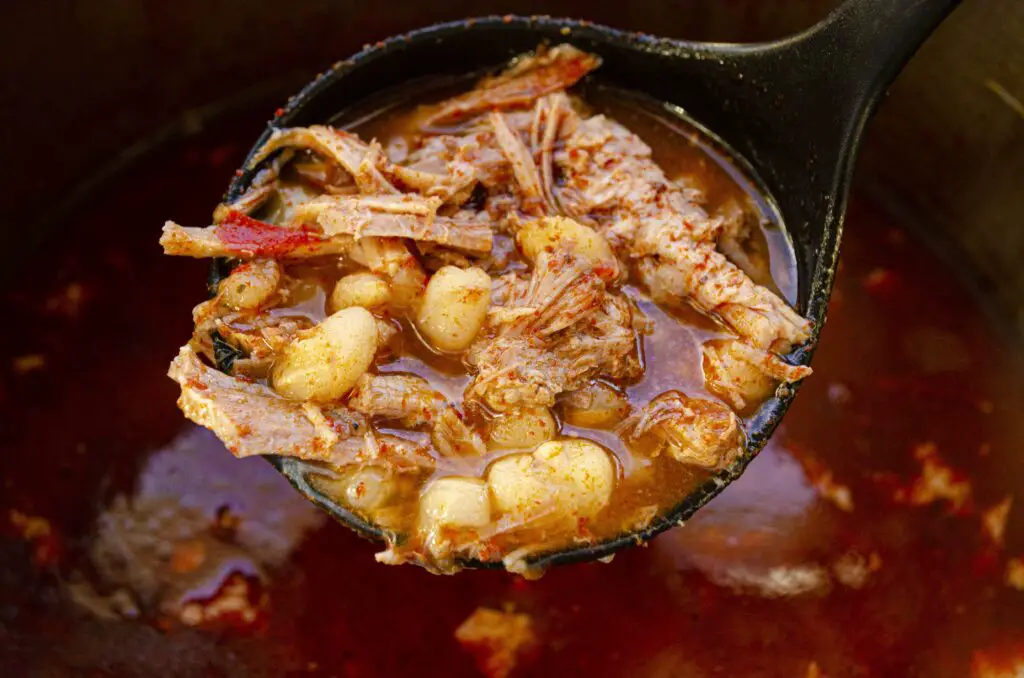
What is Pozole soup made of?
When you taste your first spoonful of Posole, chances are you will love it. It’s a very hearty soup packed with flavor that qualifies as a true Mexican comfort food classic. However you may have wondered; just what is Pozole made of? Read on for the answer.
Pozole, (also spelled Posole), is an Aztec soup originating from central America. Today it is made with a blended chile pepper sauce, hominy (corn soaked in a lime solution causing it to swell), water or broth, seasonings and shredded pork, although occasionally chicken is used as well.
I grew up eating Pozole in New Mexico, usually on Christmas eve. I would always order a cup of Posole to munch on while wandering through thousands of enchanting luminarias displayed in the plaza of my hometown. It would keep my hands, mouth, and insides, toasty warm on that special winter night.
As a state, New Mexico has done the best job by far of holding on to Mexican traditions; far better than its neighbors of Texas and Arizona. I’m not really sure why; perhaps it’s because the Spanish influence there is the oldest anywhere in the USA. So the Instant Pot Posole recipe I created for you, dear reader, in this article is a traditional New Mexican recipe complete with authentic red Hatch chile sauce.
What Pozole used to be made out of
If you enjoy true horror stories you’re in for a real treat, because ancient Pozole soup has quite a history that I’m going to share with you. If you don’t like horror feel free to skip down to the next heading- no one will think less of you- this is a judgment free zone :0)
Hundreds of years ago, before the Spanish discovered the Aztec people, Pozole soup was a sacred ‘special occasion’ soup because it was made with the flesh of sacrificial human victims killed to appease their gods for the most important ceremonies.
These victims had their hearts removed and given to the gods; and as for what was left of them, well, “waste not, want not” right?! Eeeeeeek! Yes my friends, this history is true. How do we know this? Because it was well documented by Friar Bernardino de Sahagún, a fascinating individual who spent his life observing and recording the culture of the Aztec people. Traditional Aztec Posole soup was replaced with pork meat or native animal meat when the Spaniards prohibited human sacrifice.
Franciscan Friar Bernardino de Sahagún, regarded by many as the pioneer of anthropology, spent approximately 50 years interviewing, researching and documenting everything he could about the Aztec peoples in central Mexico. He recorded the disturbing tradition of Posole soup. He learned the language and also had young Aztecs assistants who could speak Spanish,and Latin along with their native Nahuatl. The history of this man is fascinating, and you can read more about him here.
Authentic Pozole Recipe In a Pressure Cooker

This recipe for authentic New Mexican Pork Posole in an Instant Pot will be just as delicious as if you slaved over a hot stove for hours to make it. I’ve also got a few more shortcuts to suggest that will shave even more time off this meal without sacrificing any flavor, so you can have a great bowl of deeply flavored Posole for dinner on the table in less than an hour.
Starting out, this recipe features pre-made, or prepared, authentic Hatch red chile sauce. You can make this at home (I have lots of recipes for it right on this website; just search ‘red chile’) or, even better, save yourself the work and just have red chile sauce shipped right to your door from The Hatch Chile Store. An excellent resource for authentic Hatch chile products!
Some recipes for posole instruct the cook to add the dried chile pods to the pork and broth to slow cook together. The chile pods are then blended up after the pork is cooked and poured back into the soup. This is messy, time consuming, and completely unnecessary. Simply adding prepared chile sauce upfront is much, much easier and still gives that great deep smoky, mildly spicy chile flavor to your posole. Plus Hatch chile sauce makes everything even more flavorful!
Also, I highly recommend acquiring a pair of shredding scissors. If you own an Instant Pot, they are simply indispensable– going hand in hand with tons of Instant Pot recipes. The beauty of using this tool is that you can shred cooked meat right in the pot without having to remove it to a cutting board and laboriously shred hot meat by hand with forks. Ugh. You can pick up a pair of these fabulous shredding scissors right here on Amazon (it will say they are for salad, but you can totally use them for meat as well)
What are Hatch Chile Peppers?
Hatch Chile peppers are world famous for their delicious flavors, produced by the unique climate and soil composition that exists only in the Hatch Valley of Southern New Mexico. These factors combine to grow exceptional-tasting chile peppers with smoky, sweet, and hot flavor notes. More people discover Hatch Chiles each year, and their popularity continues to grow.
Growing up in New Mexico where chile peppers are an integral part of the culture, I know that Hatch chiles have earned a reputation for being the best of the best. I personally only use authentic Hatch in all my cooking because it simply tastes amazing. You should be able to find canned Hatch chile in any supermarket these days, or you can order it directly like I do. Frozen chile is much, much better tasting than canned!
The Hatch Chile Store is the premiere website for ordering your Hatch chile– they are incredibly good at shipping fresh authentic chile right to your door, whatever variety and hotness lever you prefer. It’s where I get all my Hatch Chile, and I must say the flavor really does stand out above any other chile pepper variety.
Head on over now to The Hatch Chile Store to stock up on the most delicious Hatch chile you can buy anywhere- they’ve always got great deals on your favorite products!
Did you know I have a full-color cookbook with lots more easy and delicious New Mexican recipes? You can learn more about it here!
How to make Pork Pozole
Season your pork generously with salt and pepper, and brown or sear it in the bottom of your pot with a little vegetable oil. Remember, browning = delicious FLAVOR.
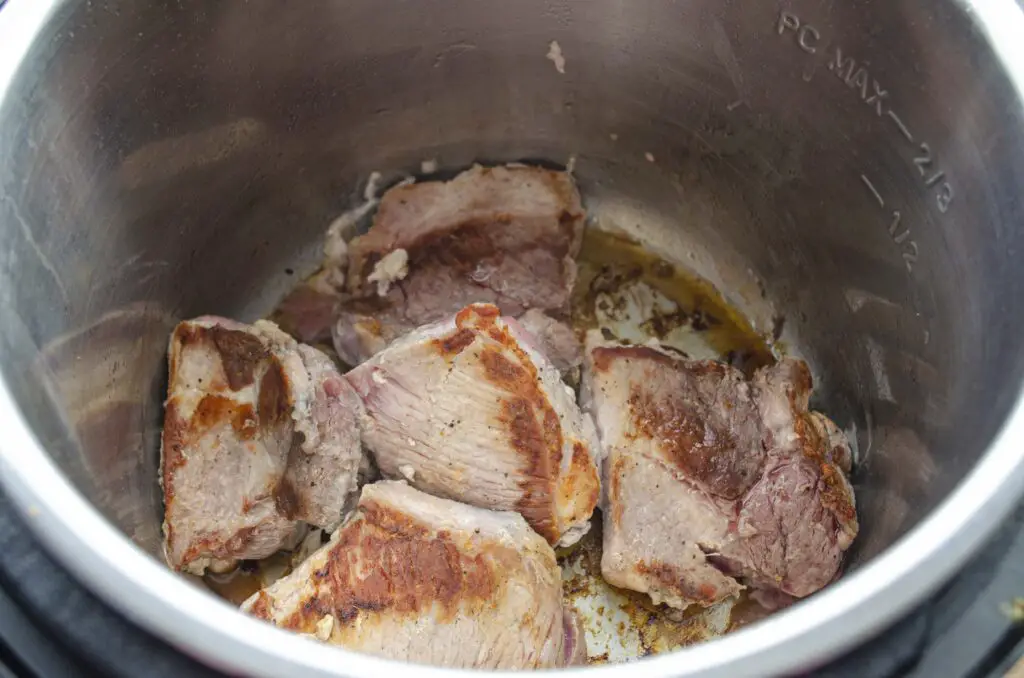
Next I remove the pork and sauté the hominy in the pork drippings with a little vegetable oil and seasonings like oregano, garlic powder and onion powder. I personally prefer to use freshly chopped onion and garlic in all my soups or stews, but since this is weeknight we can skip and go straight to powdered versions of these. I also really love a little pinch of ground coriander in this recipe. It’s a secret ingredient that gives even more depth and just blends so perfectly with the flavors of the pork and chile sauce!
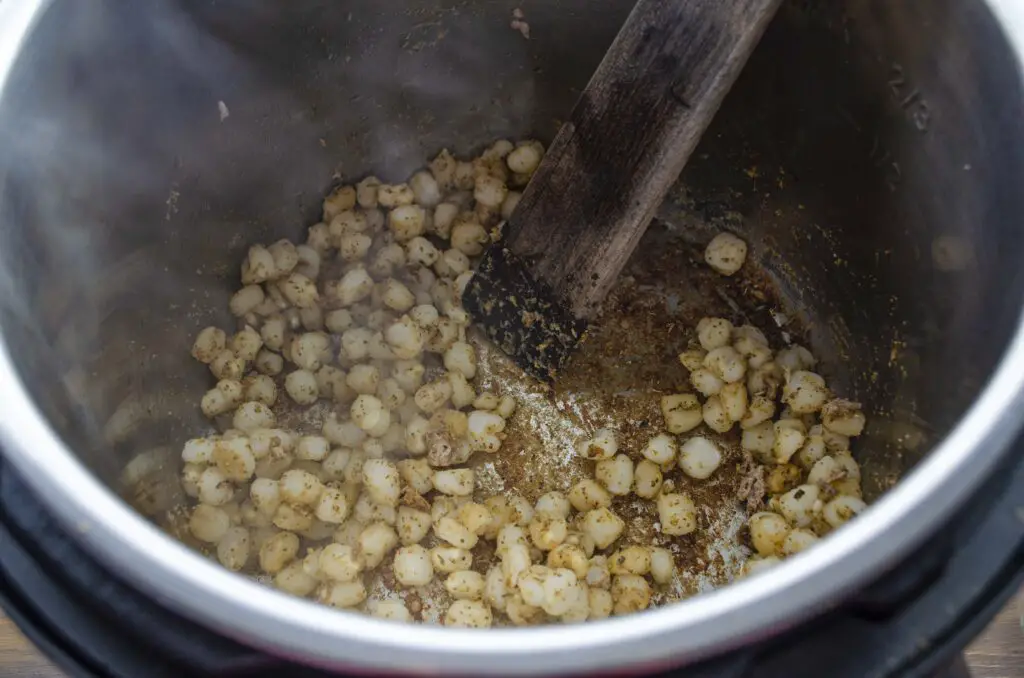
Then simply stir in broth and 1 cup of Hatch red chile sauce to the pot. Return the pork and any accumulated pork juices to the pot as well and cook it. That’s it. Crazy simple, AND simply delicious.
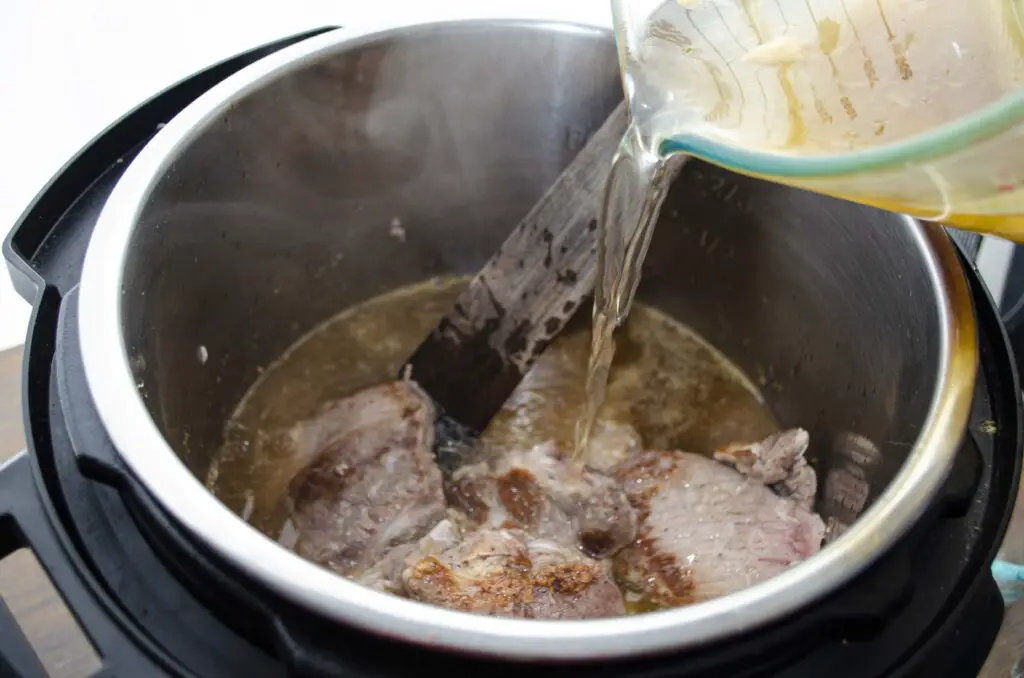
When the Pozole is done cooking, shred the meat right in the pot with those fabulous shredding scissors I mentioned earlier. And dish up a nice hot bowl of Posole for yourself or your family. Squeeze a fresh lime over each bowl for an additional pop of bright flavor. Serve with a warm flour tortilla and enjoy!


Pressure Cooker Red Chile Pork Pozole
- Total Time: 55 minutes
- Yield: 6–8 servings 1x
Description
An easy weeknight pressure cooker pork stew made with hominy, Hatch red chile sauce, pork and seasonings.
Ingredients
- 1.5 pounds boneless pork roast or boneless pork ribs
- 2 tablespoons vegetable oil, divided
- salt and pepper
- 2 cans hominy, drained and rinsed
- 1 and 1/2 tablespoons onion powder
- 2 teaspoons garlic powder
- 1/2 teaspoon ground coriander
- 1 tablespoon dried oregano
- 6 cups chicken broth
- 1 cup Hatch red chile sauce (your choice of mild, medium or hot)
- 1 small bay leaf
- optional, freshly squeezed lime juice
Instructions
- Pat roast or ribs dry with paper towels. If using roast, slice into 3 or 4 large slices. Season all sides of the pork generously with salt and pepper.
- In an instant pot set to the saute function, pour in 1 tablespoon of vegetable oil and allow it to warm and spread across the bottom. Place the pork in the bottom of your instant pot in a single layer. Let it brown for approximately 2-3 minutes without moving it. Flip and brown on the other sides, then remove to a plate and set aside.
- Add the additional tablespoon of vegetable oil to the instant pot. Pour in the hominy and seasonings and cook for approximately 2-3 minutes, to toast the hominy and bloom the spices.
- Gently pour in the broth and red chile. Stir and scrape the bottom to release any food stuck there. Add the pork and the bay leaf. Close the lid and pressure cook on high (on the meat/stew setting if you have that option) for 30 minutes. Once finished, allow the pressure to naturally release for approximately 15 minutes. Alternatively, slow cook with the slow cook feature for at least six hours.
- Remove the pork, shred it, and return to the pot. Serve with warm flour tortillas and optional freshly squeezed lime juice.
- Prep Time: 10 minutes
- Cook Time: 30 minutes
- Category: Dinner
- Method: Pressure Cooker
- Cuisine: New Mexican

